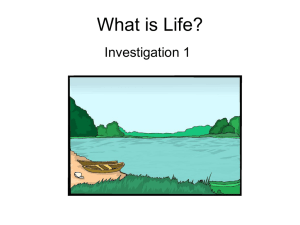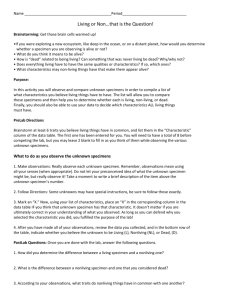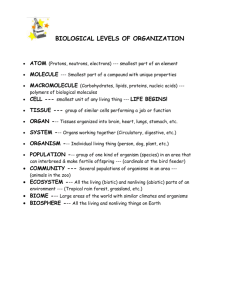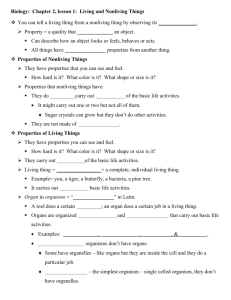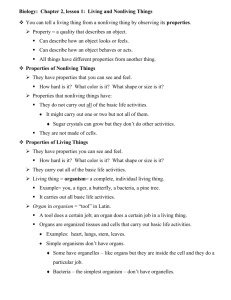Characteristics of Life
advertisement
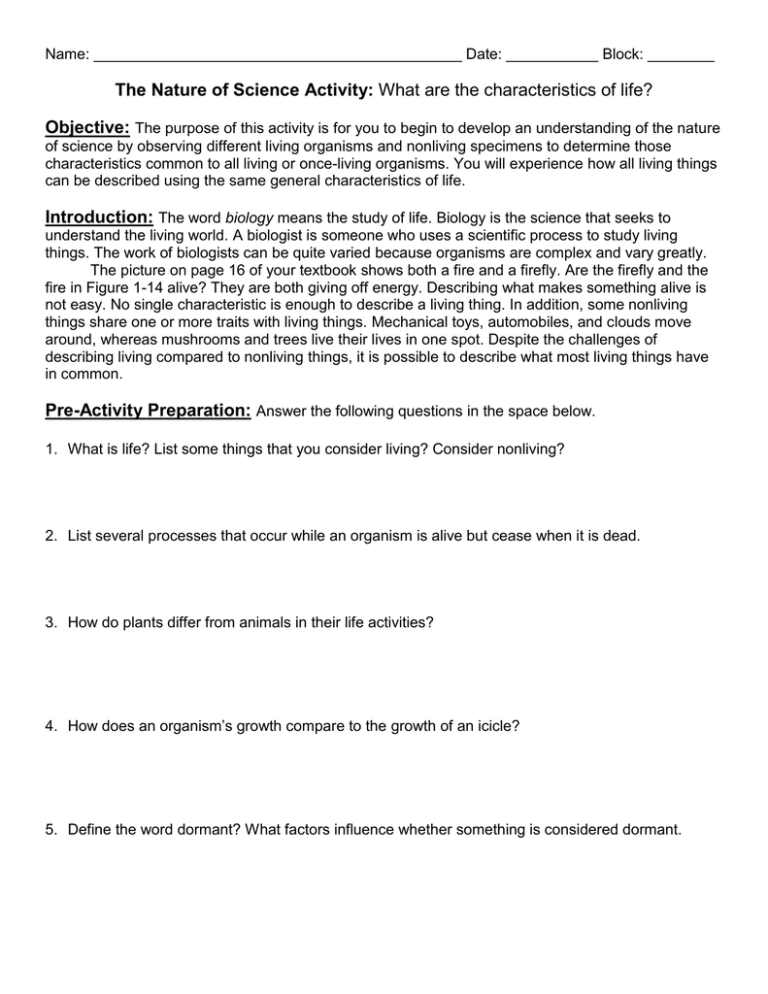
Name: ____________________________________________ Date: ___________ Block: ________ The Nature of Science Activity: What are the characteristics of life? Objective: The purpose of this activity is for you to begin to develop an understanding of the nature of science by observing different living organisms and nonliving specimens to determine those characteristics common to all living or once-living organisms. You will experience how all living things can be described using the same general characteristics of life. Introduction: The word biology means the study of life. Biology is the science that seeks to understand the living world. A biologist is someone who uses a scientific process to study living things. The work of biologists can be quite varied because organisms are complex and vary greatly. The picture on page 16 of your textbook shows both a fire and a firefly. Are the firefly and the fire in Figure 1-14 alive? They are both giving off energy. Describing what makes something alive is not easy. No single characteristic is enough to describe a living thing. In addition, some nonliving things share one or more traits with living things. Mechanical toys, automobiles, and clouds move around, whereas mushrooms and trees live their lives in one spot. Despite the challenges of describing living compared to nonliving things, it is possible to describe what most living things have in common. Pre-Activity Preparation: Answer the following questions in the space below. 1. What is life? List some things that you consider living? Consider nonliving? 2. List several processes that occur while an organism is alive but cease when it is dead. 3. How do plants differ from animals in their life activities? 4. How does an organism’s growth compare to the growth of an icicle? 5. Define the word dormant? What factors influence whether something is considered dormant. In your pods, generate a list of characteristics that you believe living things must possess in order to be classified as “living”. Then visit each numbered lab station and carefully observe the specimens. Check off all of the characteristics that you believe each specimen may have. In the columns at the top of the table make sure to write which specimen is at each lab station. Before moving on to the next station, determine the specimen to be Living = (L), Nonliving = (NL), or Dead (D); indicate your decision at the bottom of that column. Lab station specimen Characteristic 10. 9. 8. 7. L, NL, or D? 6. Dead (D) 5. Never Alive (NL) 4. Product of a Living Thing (NL) 3. Alive, but Dormant (L) 2. Alive (L) 1. Life Categories: Post-Activity Analysis: Answer and discuss the following questions with your pod. 1. How did you determine the difference between a living specimen and a nonliving one? 2. What is the difference between a nonliving specimen and one that you considered dead? 3. According to your data table, what traits do most living things have in common? 4. Referring to your answers for #3, do you think that is an accurate list for what living things have in common? Why or why not? What changes would you make, if any? 5. What traits did you list as characteristics of living things, but were not easily observable? 6. What instruments or technologies might have helped you to determine whether or not some of the unknowns are living or not? 7. Describe an experiment you could perform to resolve any questions about whether a specimen is living? 8. What traits did you pick as characteristics that were NOT helpful (did not necessarily indicate life)? Homework: Take notes on the characteristics of living things from section 1-3 in your textbook (pages 16-19). Table 1: The Characteristics of Living Organisms Characteristic Briefly Describe the Characteristic Further Analysis: Answer the following questions in complete sentences in the space provided. You should complete them on YOUR OWN and in YOUR OWN words. 9. What would be the consequence to an organism if its homeostasis is disrupted and not restored? Use an example to support your answer (outside of the one given in class). 10. For the following specimens, label them as living (L), nonliving (NL), or dead (D) and then give a short one-sentence explanation for why it belongs in this category. This is NOT meant to be a research project. Just answer what you THINK, based on what you have learned after completing this activity. And be ready to defend your answer. (Even if you are ultimately wrong, that’s okay, but really think about to which category each item belongs). a) HIV virus:___________________________________________________________________ ___________________________________________________________________________ ___________________________________________________________________________ b) Brown grass: ________________________________________________________________ ___________________________________________________________________________ ___________________________________________________________________________ c) Fertilized chicken egg: _________________________________________________________ ___________________________________________________________________________ ___________________________________________________________________________ d) Egg bought in a grocery store: __________________________________________________ ___________________________________________________________________________ ___________________________________________________________________________ e) The skin on the back of your hand: ______________________________________________ ___________________________________________________________________________ ___________________________________________________________________________ f) Hair on a fruit fly’s back: ______________________________________________________ ___________________________________________________________________________ ___________________________________________________________________________ g) Whale sperm: _______________________________________________________________ ___________________________________________________________________________ ___________________________________________________________________________ Name: ____________________________________________ Date: ___________ Block: ________ The Nature of Science Activity: What are the characteristics of life? Discussion: Use the space below to help outline your answers to the following questions. Ultimately answer the following in complete sentences in a separate Word document and upload your responses to turnitin.com. Note that research will be required to answer these questions for full credit. Please cite your sources. Make sure to include the following in your heading: Name: Partner: Title of the Activity: The first samples of the moon’s surface to be brought back by Apollo astronauts were carefully examined for signs of life. What sort of evidence do you think scientists looked for and how did they go about obtaining that information? Were there any signs of life? Explain why a Venus flytrap is considered living using the following characteristics of life: Using Energy, Growth & Development, and Evolution (adaptation). Why is it so hard to define viruses as living or nonliving?

